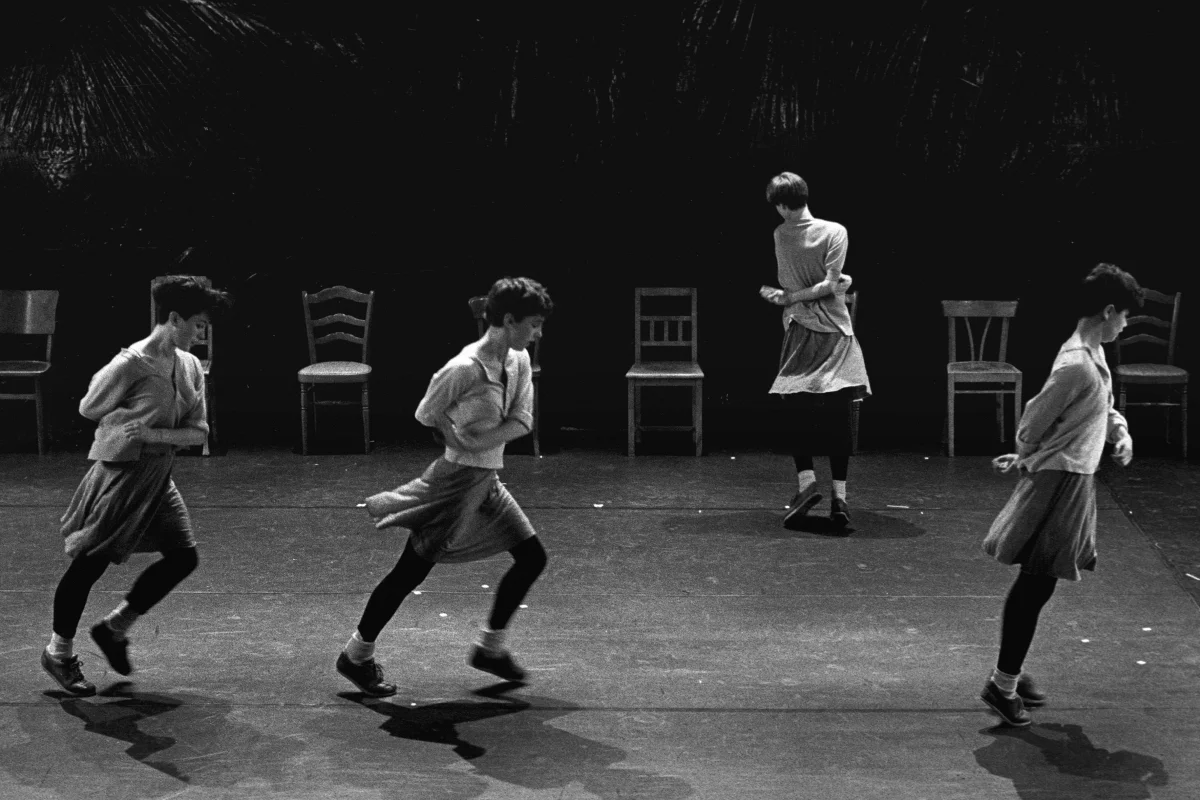Sarah Osterman Myers
Writer, Editor, Content Manager
Rosas danst Rosas
Dance Review by Sarah Osterman Myers
Published on Chicago Stage and Screen
Rosas danst Rosas— Rosas @ the MCA
As the lights dim, four women dressed in baggy shades of grey enter one by one and stand in a line facing the back; a backdrop of shimmery black folds. A bellicose beat starts to build, echoing throughout the dark theater. It clangs off the concrete steps in the audience, intensifying in volume and texture until it becomes a deafening medley of riotous percussion. And then it stops.
Silence has never felt so disorienting.
Rosas danst Rosas is 31 years old yet feels more relevant than most work being created today, which is why Belgian choreographer Anne Teresa De Keersmaeker’s signature pairing of minimalist principles and feminine flair drew a large audience to the Museum of Contemporary Art Thursday night to witness her first return in 15 years.
When Rosas danst Rosas debuted in 1983, it was an anomaly because it scored music and dance together, a departure from European standards of the time. But the synthesis of Thierry De Mey’s percussive, machine-like sounds and De Keersmaeker’s irrefutable femininity quickly caught on and transfixed the international dance scene with its timeless veracity.
In the case of Rosas danst Rosas, repetition makes the heart grow fonder. The 100 minutes are broken into five segments, each containing relentless sound, calculated pathways and recurring movement. While De Keersmaeker’s patterns are orderly and predictable— almost parallel to the tedium of daily life— the movement itself is far from robotic. If anything, the fist clenching, hair tossing, angular thrashes and heavy breathing create a sense of vulnerability and sensuality, which only builds over time and with the regularity of reiteration.
After a prolonged period of stillness and anticipation, segment one feels like an awakening from deep stagnation. The dancers roll from side to side, breathe deeply and run fingers through their hair. They show angst and physical indecision, as though rolling around in bed, deciding whether or not they have strength to face the day.
After what feels like an eternity of pensive floor work and silence, they shift into a starkly different realm for segment two. Between each section, De Keersmaeker allows her dancers to transition slowly; a choreographic choice to show the effort and fatigue she calls the physical “reverse side” of dancing. After chairs are set on a diagonal and shoes lace up, steely beats sync up with hair whipping and fast-paced, assertive gestures, turning the stage into a platform for unabashed femininity.
Segment three is subtler than two but maintains a feminine energy. A trio of repetition provides consistency as one dancer at a time walks downstage to expose her shoulder, recover it, and gaze expectantly into the audience.
Segment four feels like the true ending, even though a short coda follows, because it is a cathartic combination of powerful movement and canonized pathways. The rigor of repetition starts to wear on the dancers as they approach a point of physical exhaustion, yet they keep going. And through that continuation it becomes abundantly clear that self discovery can happen even in the confines of structure and that perfect unison is an illusion because, in moments of pure exhaustion, idiosyncrasies will always prevail.
In an interview for Oh Comely magazine blog in 2012, De Keersmaeker said: “I’m obsessed by structures. But the most beautiful experience is to see such a construction generating something intangible, elusive— an emotion.”
To see emotions come to life, don’t miss the next three scheduled shows— October 10th and 11th at 7:30pm and 12th at 3pm at the Museum of Contemporary Art. MCA members are $22, nonmembers $28 and students $10. For more information, call the MCA Box Office at 312-397-4010.
Tags: Rosas, Teresa De Keersmaeker, Peter Vermeersch, Thierry De Mey, Fumiyo Ikeda, Tale Dolven, Cynthia Loemij, Sandra Ortega Bejarano, Sue-Yeon Youn, MCA, Sarah Osterman Myers


